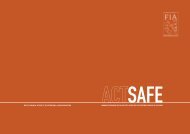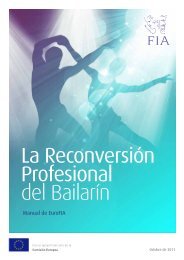EDAD GÉNERO Y EL EMPLEO DE LOS ARTISTAS- INTÉRPRETES EN EUROPA
edad, género y el empleo de los artistas- intérpretes en europa - the ...
edad, género y el empleo de los artistas- intérpretes en europa - the ...
You also want an ePaper? Increase the reach of your titles
YUMPU automatically turns print PDFs into web optimized ePapers that Google loves.
1 Directiva del Consejo 2000/78/EC<br />
2 Comunicación de la Comisión Europea COM 2006 92 Final<br />
3 Eurostat 2008: La vida de las mujeres y los hombres en Europa: Un panorama estadístico. Luxemburgo: Oficina de<br />
Publicaciones Oficiales de las Comunidades Europeas.<br />
4<strong>EDAD</strong> - la Plataforma Europea para las Personas de Edad de 2007: Promoviendo la igualdad de género para las personas<br />
mayores en la Unión Europea. Bruselas.<br />
5 Itzin, C. and Newman, J. (editores.) 1995: Género, Cultura y Cambio Organizativo. Londres: Routledge.<br />
6 Anker, R. 1997: Theories of occupational segregation by sex: An overview, International Labour Review, 136 (3), 315-339;<br />
Hakim, C. 1979: Occupational Segregation: A comparative study of the degree and pattern of the differentiation between<br />
men and women’s work in Britain, the United States and other countries, Department of Employment Research Paper<br />
No.9. London: Department of Employment; Women and Work Commission 2006: Shaping a Fairer Future. London:<br />
Department of Trade and Industry; véase también Franco, A. 2007: The concentration of men and women in sectors of<br />
activity. Luxembourg: Office for Official Publications of the European Communities.<br />
7 Anker ibid., p.337.<br />
8 Además, la membresía del RU está dividido: 50: 50 entre hombres y mujeres, similar a las respuestas de conjunto de la<br />
encuesta; el 11 % de los encuestados del Reino Unido son de un grupo minoritario étnico o negro, lo que<br />
aproximadamente equivale a la proporción de minorías negras y étnicas general del RU; el 5% de los encuestados indicó<br />
que tenían un impedimento, cercano al 7% de la población general del RU.<br />
9 Véase por ejemplo: Thomas, H. (1995), Unequal Pay for Equal Parts: a survey of performers in the theatre and the<br />
electronic media. London, Equity; Cliche, D., Mitchell, R. and Wiesand, A.J. (eds.), 2000: Pyramids or Pillars, Unveiling<br />
the Status of Women in Arts and Media Professions in Europe. Bonn: ARCult Media; EuroFIA affiliates in Denmark,<br />
Sweden and Norway have also produced research on these issues (details available through FIA http://www.fiaactors.com/).<br />
10 Dean, D. 2005: Recruiting a Self: Women Performers and Aesthetic Labour, Work, Employment and Society, 19 (4), 763-<br />
766; Dean, D. 2004: Women Performers as Workers: Gender in Relation to Aspects of Industrial Relations in Theatre and<br />
Television, unpublished PhD thesis, Warwick Business School: University of Warwick;<br />
11 Estas son cifras comunicadas a la FIA por sus sindicatos europeos y corresponden al total de cantidad de afiliados<br />
representados por el sindicato.<br />
12 1% de los encuestados no respondió a esta pregunta.<br />
13 Nótese que no todos los encuestados indicaron su origen étnico.<br />
14 Cottle, S. 1998: Making ethnic minority programmes inside the BBC: professional pragmatics and cultural containment,<br />
Media, Culture & Society, 20, 295-317.<br />
15 Reino Unido 50: 50; Finlandia SNL 50:50; Italia SAI mujeres 42% hombres 58%; Portugal STE mujeres 36% hombres<br />
64%; Letonia LKDF mujeres 44 % hombres 56%; República Checa mujeres 52% hombres 48%; Suecia Teaterforbundet<br />
mujeres 53% hombres 47%; Alemania GDBA 52% mujeres 48% hombres; Bélgica ACOD CULTUUR 43% mujeres 57%<br />
hombres; Suiza SSRS 55% mujeres 45% hombres; Francia 47% mujeres 53% hombres; Austria KMSFB 33% mujeres<br />
66% hombres; Irlanda 50% mujeres 50% hombres; Noruega Norsk Skuespillerforbund 56% mujeres 44 % hombres.<br />
16 Organización Internacional del Trabajo 1992: Tripartite Meeting on Conditions of Employment and Work of Performers,<br />
Final Report, p.45. Ginebra: Organización Internacional del Trabajo.<br />
17 Véase también: Employment and European Social Fund 2001: Exploitation and development of the job potential in the<br />
cultural sector: Final Report. Luxembourg: European Commission.<br />
18<br />
34







